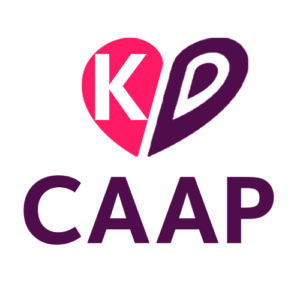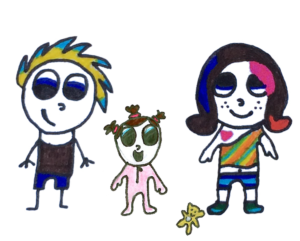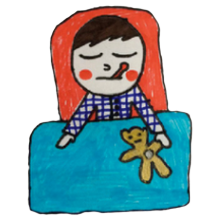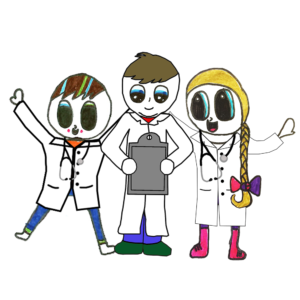 Understanding the KD-CAAP Trial
Understanding the KD-CAAP Trial
How did KD-CAAP begin?
A parent, whose child had Kawasaki Disease as a baby, established Societi Foundation, the UK Foundation for Kawasaki Disease in 2015. She wanted to create an organisation with information and support for families affected by Kawasaki Disease – when her family had gone through it, she’d found nothing she could rely on or trust. She was also concerned that there was no focus for action on Kawasaki Disease in the UK. So in May 2016, just a few months after starting the charity, she brought the leading doctors in the UK with expertise in Kawasaki Disease together, and asked them – “If we did one thing to help children affected by Kawasaki Disease most, what would it be?”
The doctors unanimously said “We urgently need to find better treatments for children who have Kawasaki Disease and prevent so many children having serious, life long heart problems.”
From that meeting, work began to design a trial (known as KD-CAAP) to add an extra medicine (a steroid) into the usual treatment for Kawasaki Disease, to find out if this could reduce heart damage in affected children.
The work was detailed, and took several years – to design the trial and find a funder who was interested in investing in this very important research.
Families at the heart of KD-CAAP design
 Right at the heart of the trial design were families. We brought families together who had been affected by Kawasaki Disease, and had themselves been through the treatments, hospitalisation, follow up visits and more – and we asked them “Help us to design this trial. Use your experience caring for your poorly child through Kawasaki Disease to help us decide on how we shape the trial, what tests we use and how the children can best be looked after during and after their stay in hospital.”
Right at the heart of the trial design were families. We brought families together who had been affected by Kawasaki Disease, and had themselves been through the treatments, hospitalisation, follow up visits and more – and we asked them “Help us to design this trial. Use your experience caring for your poorly child through Kawasaki Disease to help us decide on how we shape the trial, what tests we use and how the children can best be looked after during and after their stay in hospital.”
Our families worked with us to decide on things like the number of blood tests which might be acceptable, and the length of time after discharge from hospital that it would be ok to keep seeing the doctor for check ups.
Families choose extra checks, extra care
 Without exception, ALL our families felt that they would have been reassured by extra tests and extra checks from experienced doctors who really knew Kawasaki Disease, if they’d been invited to take part in the trial, and that they’d choose the trial rather than standard treatment alone, because of this really valuable extra support – whether or not they got the extra medicine the trial is looking to test. That feedback really helped doctors as they planned the trial because they knew we need families to feel confident about taking part in the trial.
Without exception, ALL our families felt that they would have been reassured by extra tests and extra checks from experienced doctors who really knew Kawasaki Disease, if they’d been invited to take part in the trial, and that they’d choose the trial rather than standard treatment alone, because of this really valuable extra support – whether or not they got the extra medicine the trial is looking to test. That feedback really helped doctors as they planned the trial because they knew we need families to feel confident about taking part in the trial.
Families also told us, without exception, that having very close monitoring of their child’s health because they were part of a clinical trial, with the option of additional treatments if their child was unwell, would be a huge benefit to taking part in the trial.
Why this trial is so important – hear from the parent who helped get it underway…
 The KD-CAAP clinical trial is the single BIGGEST opportunity in a generation to make a difference for children affected by Kawasaki Disease. It’s a ground-breaking trial, connecting communities of brilliant doctors from across the UK and Europe – using their shared knowledge and experience to help our children.
The KD-CAAP clinical trial is the single BIGGEST opportunity in a generation to make a difference for children affected by Kawasaki Disease. It’s a ground-breaking trial, connecting communities of brilliant doctors from across the UK and Europe – using their shared knowledge and experience to help our children.
Success will depend on people taking part, and having been the catalyst for this trial back in 2016, the Founder of Societi Foundation, Rachael McCormack said “This is such an important trial. We just must have better treatments for children who are affected by Kawasaki Disease – today it’s the leading cause of acquired heart disease in children and we really want to change this.
I find it shocking that 39% of babies under 1 year in the UK with Kawasaki Disease go on to develop life threatening heart damage with current treatments – and 1 in 5 of all children who have Kawasaki Disease will need care for life, as they are left with serious heart damage – even if they get the standard medicines on offer. Similar, terrible harm is happening to children across Europe who have Kawasaki Disease and KD-CAAP has the potential to help change this – benefitting thousands of children in the future if the additional medicine it is testing works as doctors hope it will. We are determined to stop this devastating impact on so many children – finding new treatments through KD-CAAP is really urgent.
I’m so very (very!) glad KD-CAAP is up and running, and that so many wonderful families have already chosen to take part. They will get excellent care and close monitoring from doctors who really know Kawasaki Disease – as well as play a very important part in protecting children’s tiny hearts in the future! I wish I had been given the opportunity to take part in such an amazing trial when my daughter had Kawasaki Disease and I’m very proud that, through our close work with the doctors leading the trial, the experience families who take part will have has been carefully shaped by families who have been through Kawasaki Disease themselves.”
More on KD-CAAP – jargon busting and key questions!
 Clinical trials and the information shared about them often use a lot of jargon and technical information which can be difficult to understand. We have tried to explain our KD-CAAP trial in a way that is helpful and doesn’t use too much jargon. We hope we’ve been successful! But get in touch if there’s anything we need to do to explain things better.
Clinical trials and the information shared about them often use a lot of jargon and technical information which can be difficult to understand. We have tried to explain our KD-CAAP trial in a way that is helpful and doesn’t use too much jargon. We hope we’ve been successful! But get in touch if there’s anything we need to do to explain things better.
For doctors and those with medical knowledge, you can find more information on trial details including information on types of participants, interventions, hypothesis, outcome measures and more – here
Explaining the technical jargon
For families considering taking part in the trial, here’s some jargon busters:
Types of participants: That’s the range of people (in our trial, children) who will be invited to take part in the trial. For KD-CAAP that’s infants and children affected by Kawasaki Disease when they are first ill, being treated at one of the hospitals taking part in the trial and who are aged between 30 days (infants from one month old) and 15 years old. We know that a lot of children, young people and adults live with the consequences of Kawasaki Disease having had it as a child. This trial isn’t for those people, but for children who are first being affected right now.
There are other criteria too which might affect whether a child with Kawasaki Disease can be invited to join the trial. One example of a criteria which would exclude someone from being able to join the trial would be if they already have a heart condition. This is because it would be hard to decide whether that existing condition affected their outcome (see below) or if that was as a result of the treatment they had. If you have been invited to join the trial, your doctors will have discussed this with you in more detail.
Interventions: These are the things we plan to do, to try and make changes happen. In our KD-CAAP clinical trial, the interventions are the treatments we give the children who take part in the trial.
Our KD-CAAP trial will select children at random to receive two different treatments (interventions):
Half will receive the normal treatment: IVIG + aspirin
Half will receive standard treatment and one additional medicine, a steroid – so they will have: IVIG + aspirin + corticosteroid
Hypothesis: This is the point for which we gather evidence to prove, or disprove. Doctors have a hypothesis – or idea – that by including an additional medicine in the initial treatment for Kawasaki Disease we might (but we might not!) reduce the number of children who have serious heart damage. The “hypothesis” is the central idea around which the trial “interventions” are designed.
Outcome measures: These are linked directly to the things we think might be achieved as a result of the trial – and how we measure them. For our trial, our “hypothesis” or idea is that we might see a reduction in serious heart damage (coronary artery aneurysms) in the group of children who receive the extra medicine (steroids). The purpose of the trial is to see if this idea is correct. Our outcome measures will therefore include looking at any difference between those children given the standard treatment, and those having the additional medicine – and of those, how many are affected with serious heart damage.
There will be a number of other outcome measures too. But this is the main one.
Why don’t all children get the treatment with steroids if you think this might help?
 That’s a great question. As parents and carers – and doctors – we want to be able to give our children the best possible treatment. Our trial is investigating whether adding steroids to the usual treatment for Kawasaki Disease will make a difference and reduce the serious heart damage. At the moment, we don’t know. We think it might but we don’t have the evidence we need to show this. That is why this trial is so important. Children getting the standard treatment (which you’d get if you weren’t taking part in the trial) who are part of our trial will help us understand more – and compare whether adding in the new treatment makes a difference. Without this group, we couldn’t properly understand whether the treatment including steroids was better than the standard treatment.
That’s a great question. As parents and carers – and doctors – we want to be able to give our children the best possible treatment. Our trial is investigating whether adding steroids to the usual treatment for Kawasaki Disease will make a difference and reduce the serious heart damage. At the moment, we don’t know. We think it might but we don’t have the evidence we need to show this. That is why this trial is so important. Children getting the standard treatment (which you’d get if you weren’t taking part in the trial) who are part of our trial will help us understand more – and compare whether adding in the new treatment makes a difference. Without this group, we couldn’t properly understand whether the treatment including steroids was better than the standard treatment.
Why steroids?
 Corticosteroids (steroids) are an effective treatment for virtually all forms of vasculitis (inflammatory diseases), but they have not been used regularly as a treatment for Kawasaki Disease. Children at known risk of developing complications from Kawasaki Disease are sometimes treated with steroids as well as standard treatment, but this doesn’t happen often.
Corticosteroids (steroids) are an effective treatment for virtually all forms of vasculitis (inflammatory diseases), but they have not been used regularly as a treatment for Kawasaki Disease. Children at known risk of developing complications from Kawasaki Disease are sometimes treated with steroids as well as standard treatment, but this doesn’t happen often.
There have been studies and trials in a number of countries elsewhere in the world which suggest significant reduction in heart damage is possible for children who receive steroids as part of their initial treatment for Kawasaki Disease. But in the UK and Europe their use hasn’t been adopted by doctors – because there hasn’t been a UK or European study on whether or not this is an effective treatment for our populations.
So, there’s has been an ongoing debate amongst doctors about whether or not children should be treated with steroids at the onset of Kawasaki Disease, together with the standard treatment.
Our trial has been designed to provide the missing evidence about the effectiveness of adding in steroids alongside standard treatment. The trial will show whether or not steroids make a difference to outcomes and whether they can help reduce serious heart damage in children affected by Kawasaki Disease.
Who is managing the trial?
KD-CAAP is managed by the Medical Research Council (MRC) Clinical Trials Unit.
What is Societi’s role?
 We are a co-investigator in the trial, and have responsibility for patient and public involvement throughout the trial period. We were involved in the trial planning and design – and involved families in the trial design process to help us shape it.
We are a co-investigator in the trial, and have responsibility for patient and public involvement throughout the trial period. We were involved in the trial planning and design – and involved families in the trial design process to help us shape it.
We’ll be raising awareness of the trial (and Kawasaki Disease!) throughout the project and we’ll be working to provide the information families need as they consider joining the trial – and if they do join, provide the information they need before, during and after their active involvement in the trial.
Who is funding and sponsoring KD-CAAP?
Innovative Medicines Initiative 2 Joint Undertaking (JU) that supports the conect4children (c4c) research consortium have provided funding for the trial.
The trial is sponsored by University College London (UCL).


